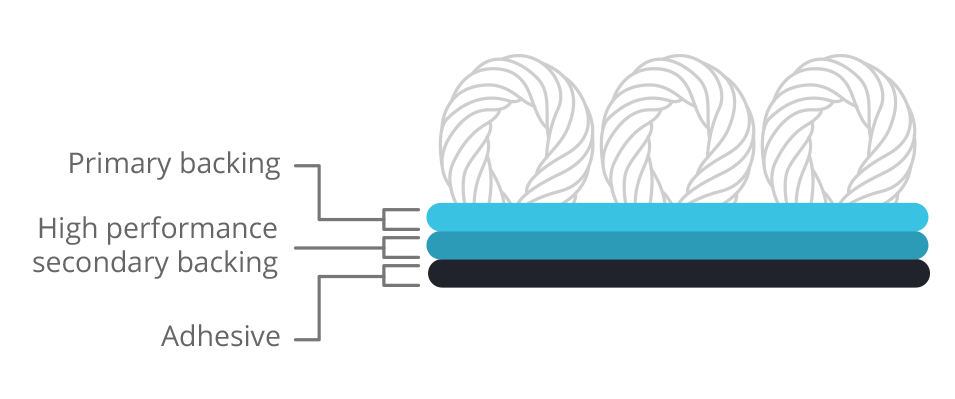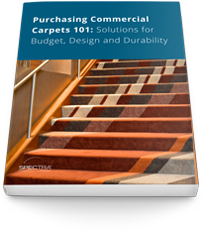Waterproof carpeting: A buyer’s guide to products for high-moisture environments
Commercial carpeting is cost-effective, durable and aesthetically pleasing. In heavy-duty commercial applications, however, excess moisture can negatively affect your carpet’s performance.
That’s why facility managers often seek out waterproof carpeting solutions — avoiding moisture problems such as stains, delamination and soiling is an attractive proposition for any building owner.
For intensive commercial applications, you’ll want to select a carpeting system that provides benefits such as:
- Stain resistance
- High tolerance to moisture
- Long-lasting value
- Robust warranty protection from the manufacturer
But while there are plenty of products that provide all of those benefits (and more) — there aren’t any “waterproof” carpeting products on the market today. Instead, they are referred to as “moisture resistant,” and provide the high tolerances to stains and moisture that many commercial applications require.
Moisture-resistant carpeting can withstand stains, spills and wear — even in heavy-duty applications, like schools, nursing homes and offices. These carpets can resist anything topically applied, like ketchup or water spills. They’ll also protect your flooring from below, adhering to your subfloor even in high-moisture situations.
Moisture-resistant carpeting provides everything you’d expect from a “waterproof” carpet. But it isn’t a substitute for moisture remediation where visible moisture is present or hydrostatic issues are present.
From product selection to proper installation, this buyer’s guide to moisture-resistant carpeting will show you how to avoid moisture problems and achieve the highest long-term value for your building.

How moisture affects the performance of your carpet (and why surface prep matters)
There are two ways moisture can affect the performance of your carpet: from above and from below. Moisture-resistant carpet is designed to protect against both.
-
Moisture from above: Stains and spills
When liquid or food is spilled onto a moisture-resistant carpet, the impervious backing prevents it from seeping into the subfloor. The spill will remain on top of the carpet and resist staining until you clean it. As with any flooring system, though, there isn’t a substitute for proper maintenance — you’ll need to clean spills promptly to prevent staining and soiling.
-
Moisture from below: Vapor from your concrete subfloor
Vapor from your concrete subfloor poses the biggest threat to the performance of your flooring. Excess moisture can break down your adhesive, causing delamination and, ultimately, the failure of your flooring system.
Most commercial buildings have a concrete subfloor — and all concrete is made by mixing cement and aggregate with water. When concrete is first laid, it has a high relative humidity (RH), meaning more moisture is present in the slab. The RH of your concrete subfloor will go down over time as the water evaporates. Flooring products —and especially adhesives— typically require the RH be below a certain threshold prior to installation.
-
Why testing your subfloor is vital to the performance of your carpet
Installing carpeting on a slab with a higher RH than permitted can void your product’s warranty and result in failure of your floor covering.
That’s why your flooring contractor needs to test the RH of the subfloor prior to installing your carpet. Most moisture-resistant carpeting systems can be installed at up to 95% RH, although there are certain products that are rated for up to 100% RH, provided there is no visible moisture present. Visible moisture typically points to greater structural issues —such as pooling ground water, a burst pipe or hydrostatic pressure— which will need to be dealt with through moisture remediation prior to installation.
Nine times out of ten, the RH is below the threshold for the product and the installation can occur. Testing prior to installation prevents the possibility of damage and ensures you have the full backing of your manufacturer’s warranty.
To learn more about the importance of testing and surface preparation —and how to prevent moisture problems— read our in-depth explanation of moisture remediation.
Product selection: What to know when selecting a moisture-resistant carpet
The right moisture-resistant carpet should do more than protect against water damage — it should be environmentally-friendly, resist stains and wear, and stand up to the unique challenges of your application.
The heavy lifting of a moisture-resistant carpet is done by the backing and the adhesive. Specially designed backings can protect your carpet from moisture in both directions — from above and below. And moisture-resistant adhesives are designed to remain bonded to the concrete, even in high RH conditions — typically up to 95%, though some products are rated up to 100%.

Beyond adhesive and backing, you should consider the face material and type (tile or broadloom) to choose the carpet type that best fits your design vision, budget and performance needs.
-
Broadloom vs. carpet tiles: Which is better for moisture resistance?
Both broadloom and carpet tile products offer the same amount of stain-, spill- and moisture-resistance. The type you choose will hinge on how long you need it to last and much you’re willing to spend.
Generally speaking, broadloom is the cheaper option. For ease of installation and maintenance, though, carpet tiles win. Whereas you need a forklift to transport broadloom carpet, a box of carpet tiles weighs a mere 10 or 15 pounds. And it’s much easier to remove and replace a 2×2 carpet tile if it’s damaged than a 12-foot broadloom roll.
Essentially, if you’re a Class A office building that needs the product to last 15 years, you’ll probably want a higher-end carpet tile. If, however, you’re a startup that just needs something to cover the concrete for the next few years, broadloom probably makes more sense.
-
Stain resistance considerations: Solution-dyed vs. piece-dyed carpeting
To maximize surface-level stain resistance, you need to choose the right type of face material (the yarn that’s visible when your carpet is installed) and dye.
Although there are other effective options, nylon face material accounts for the overwhelming majority of commercial carpeting in the U.S. And for good reason — it’s highly durable and stain resistant. For the greatest stain resistance, you’ll likely want to select a solution-dyed nylon product.
The term “solution-dyed” refers to the way color is added to the yarn. Solution-dyed yarn is melted down, dyed and then re-spun into thread, meaning the color is consistent throughout the thread rather than printed on top as in piece-dyed carpet. Because the color is throughout the carpet fibers, wear of the outer layer is unnoticeable.
-
Moisture-resistant carpet backing
The ideal moisture-resistant backing is impervious, meaning no water can seep through it into your concrete subfloor. This also keeps spills on top of the carpet, reducing wick-back stains and soiling.
Many manufacturers offer products that will perform in high-moisture environments — up to and above 95% RH. Typically, a moisture-resistant backing is comprised of several layers including a thermoplastic laminate to prevent delamination, fiberglass for added stability and cushion to reduce foot fatigue.
Look for a high-performance backing that meets your moisture requirements, and that’s warranted for the duration you’ll be using the product. Your flooring contractor will guide you toward the most cost-effective solution for your application.
-
Water-resistant adhesive
The goal of a water-resistant adhesive is to remain bonded to the subfloor, even in high-moisture situations.
Traditionally, carpeting adhesives were solvent-based, meaning that water moisture wouldn’t dissolve them. New environmental standards have called for the use of water-based flooring adhesives over solvent-based adhesives. While water-based adhesives present many benefits for the environment —better indoor air quality, points toward LEED certification— they can dissolve if the RH exceeds a certain threshold.
You’ll need to test the floor’s RH level. A variety of manufacturers have full-spread water-based glues rated up to 95% RH, meaning anything below 95% is covered under their manufacturer’s warranty. Although there are a couple adhesives rated up to 100% RH, no product should be installed if there is visible moisture present.
You’ll want to work with your flooring contractor to select the right adhesive for your carpet system – and ensure it’s installed according to the requirements of the manufacturer’s warranty.
You need to consider more than just initial price when deciding between moisture-resistant carpeting products. Look at the specifications for each product you’re considering and dig into the details of the warranty. You’ll want to choose a product that not only meets your moisture requirements, but also has a warranty that’ll protect it throughout its usable life. And don’t underestimate your flooring contractor’s recommendation. They’ll have a good idea which products best fit your budget and moisture-resistance needs.
For more information on selecting the right carpet for your budget, design needs and facility environment, download our Purchasing Commercial Carpets 101 guide. You’ll learn the pros and cons of different carpet types, how to assess a carpet’s quality and more.

Selecting carpet for your budget, interior design and facility environment
Selecting a carpet that matches your design vision, stands up to your facility environment and aligns with your budget is no small task. We’ve created this guide as a resource to help you make an informed carpet purchasing decision.
